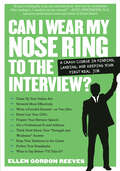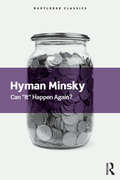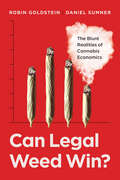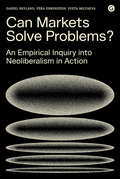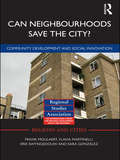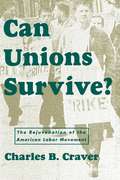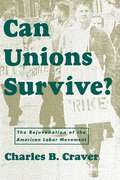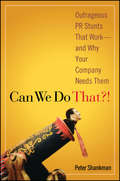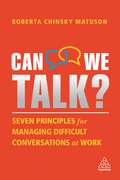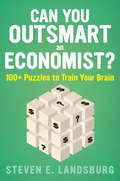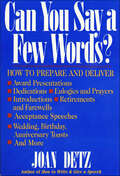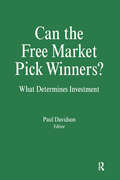- Table View
- List View
Can I Wear My Nose Ring to the Interview?: A Crash Course in Finding, Landing, and Keeping Your First Real Job
by Ellen Gordon ReevesA witty, friendly, unexpected job hunter's bible that finally answers the real questions. Yes, if you're wedded to your nose ring, wear it to the interview. No, you shouldn't be e-mailing out hundreds of résumés. Writing with enormous authority and a compelling, lively voice, Ellen Reeves brings together her lifetime of experience of hiring, counseling, and résumé-doctoring into an essential guide for young job seekers.Can I Wear My Nose Ring to the Interview? takes readers step-by-step through a process that was always tough, but is today especially challenging. Begin the search with a professional mind-set—get organized, and set yourself up with business cards, a respectable e-mail address, and a working cell phone. The importance of networking and the rule of three—try to make three e-mails or phone calls a day, but never more than that. The "elevator speech"—hone your pitch to the length of an elevator ride and be prepared to use it at the most unexpected times. The art of writing cringe-free cover letters and killer résumés—from timelines, hooks, and grammatical do's and don'ts to why you should never use the phrase "References available upon request," never include your GPA, and never, ever make a typo. How to dress for an interview, including why to put on your business clothes when interviewing at home, over the phone. Things to be honest about: citizenship and past salary range. And things not to say: "I want this job because I need health insurance."Then once you're in, how to negotiate salary, what to expect in a review, and basic first job common sense: take initiative, be humble and helpful, never use your boss as a confidant, and always say "I'll find out" instead of "I don’t know." Now you're on your way.
Can It Happen Again?: Essays on Instability and Finance (Routledge Classics)
by Hyman MinskyIn the winter of 1933, the American financial and economic system collapsed. Since then economists, policy makers and financial analysts throughout the world have been haunted by the question of whether "It" can happen again. In 2008 "It" very nearly happened again as banks and mortgage lenders in the USA and beyond collapsed. The disaster sent economists, bankers and policy makers back to the ideas of Hyman Minsky – whose celebrated 'Financial Instability Hypothesis' is widely regarded as predicting the crash of 2008 – and led Wall Street and beyond as to dub it as the 'Minsky Moment'. In this book Minsky presents some of his most important economic theories. He defines "It", determines whether or not "It" can happen again, and attempts to understand why, at the time of writing in the early 1980s, "It" had not happened again. He deals with microeconomic theory, the evolution of monetary institutions, and Federal Reserve policy. Minsky argues that any economic theory which separates what economists call the 'real' economy from the financial system is bound to fail. Whilst the processes that cause financial instability are an inescapable part of the capitalist economy, Minsky also argues that financial instability need not lead to a great depression. This Routledge Classics edition includes a new foreword by Jan Toporowski.
Can Legal Weed Win?: The Blunt Realities of Cannabis Economics
by Dr. Robin Goldstein Prof. Daniel SumnerTwo economists take readers on a tour of the economics of legal and illegal weed, showing where cannabis regulation has gone wrong and how it could do better. Cannabis "legalization" hasn't lived up to the hype. Across North America, investors are reeling, tax collections are below projections, and people are pointing fingers. On the business side, companies have shut down, farms have failed, workers have lost their jobs, and consumers face high prices. Why has legal weed failed to deliver on many of its promises? Can Legal Weed Win? takes on the euphoric claims with straight dope and a full dose of economic reality. This book delivers the unadulterated facts about the new legal segment of one of the world's oldest industries. In witty, accessible prose, economists Robin Goldstein and Daniel Sumner take readers on a whirlwind tour of the economic past, present, and future of legal and illegal weed. Drawing upon reams of data and their own experience working with California cannabis regulators since 2016, Goldstein and Sumner explain why many cannabis businesses and some aspects of legalization fail to measure up, while others occasionally get it right. Their stories stretch from before America's first medical weed dispensaries opened in 1996 through the short-term boom in legal consumption that happened during COVID-19 lockdowns. Can Legal Weed Win? is packed with unexpected insights about how cannabis markets can thrive, how regulators get the laws right or wrong, and what might happen to legal and illegal markets going forward.
Can Marketing and Manufacturing Coexist?
by Benson P. ShapiroEvery manufacturing company experiences conflict, often internecine, between its marketing and manufacturing functions. There is a strong likelihood of conflict in managing the marketing/manufacturing interface in eight areas: capacity planning and long-range sales forecasting; production scheduling and short-range sales forecasting; delivery and physical distribution; quality assurance; breadth of product line; cost control; new product introduction; and adjunct services.
Can Markets Solve Problems?: An Empirical Inquiry into Neoliberalism in Action (Goldsmiths Press / PERC Papers)
by Daniel Neyland Vera Ehrenstein Sveta MilyaevaA provocative analysis of market-based interventions into public problems and the consequences.Market-based interventions have been used in attempts to solve numerous public problems, from education to healthcare and from climate change to privacy. Scholars have responded persuasively through critiques of neoliberalism. In Can Markets Solve Problems? Daniel Neyland, Véra Ehrenstein, and Sveta Milyaeva propose a different route forward.There is no single entity knowable as “the market,” the authors argue. Instead, they examine in detail the devices, relations, and practices that underpin these market-based interventions. Drawing on recent work in science and technology studies (STS), each chapter focuses on a different intervention and critically explores the market sensibility around which it is organized. Trade and exchange, competition, property and ownership, and investment and return all become the focus of a thorough exploration of what it means to intervene in public problems, how problems are composed, and how solutions are continually reworked.Can Markets Solve Problems? offers the first book-length STS enquiry into markets and public problems. Weaving together rich empirical descriptions and conceptual discussions, the book provides in-depth insights into the workings of these markets, their continuous evolution, and the consequences. The result is a new avenue of critical inquiry that moves between the details of specific policies and the always-emerging, collective features of this landscape of intervention.
Can Mexico Make Democracy Work?
by Jonathan Schlefer Gunnar TrumbullEnrique Pe a Nieto, the presidential candidate of the old Mexican ruling party elected in 2012, passed the most fundamental reforms in at least two decades. They included allowing private competition in the energy sector, including with the state-owned oil company, Pemex; strengthening competition in the telecoms industry; promoting private-bank and public development-bank lending. Also, political reforms allowed re-election (formerly prohibited) to all legislative posts, and gave key regulatory agencies independence from the executive. Would these reforms actually be implemented on the ground? Would they achieve good growth for more jobs and better income distribution? Would they finally make Mexican democracy work, or partly restore the hegemony of the old ruling party?
Can Neighbourhoods Save the City?: Community Development and Social Innovation (Regions And Cities Ser. #39)
by Frank MoulaertFor decades, neighbourhoods been pivotal sites of social, economic and political exclusion processes, and civil society initiatives, attempting bottom-up strategies of re-development and regeneration. In many cases these efforts resulted in the creation of socially innovative organizations, seeking to satisfy the basic human needs of deprived population groups, to increase their political capabilities and to improve social interaction both internally and between the local communities, the wider urban society and political world. SINGOCOM - Social INnovation GOvernance and COMmunity building – is the acronym of the EU-funded project on which this book is based. Sixteen case studies of socially-innovative initiatives at the neighbourhood level were carried out in nine European cities, of which ten are analysed in depth and presented here. The book compares these efforts and their results, and shows how grass-roots initiatives, alternative local movements and self-organizing urban collectives are reshaping the urban scene in dynamic, creative, innovative and empowering ways. It argues that such grass-roots initiatives are vital for generating a socially cohesive urban condition that exists alongside the official state-organized forms of urban governance. The book is thus a major contribution to socio-political literature, as it seeks to overcome the duality between community-development studies and strategies, and the solidarity-based making of a diverse society based upon the recognising and maintaining of citizenship rights. It will be of particular interest to both students and researchers in the fields of urban studies, social geography and political science.
Can Pay Be Strategic?
by Jonathan TrevorCan Pay Be Strategicprovides a timely insight into the challenges faced by leading organizations when attempting to deploy pay systems in the pursuit of strategic priorities. Based upon in-depth case study research, this book reveals a number of managerial obstacles to the effective management of contemporary pay systems and the dysfunctionalities and negative outcomes that are an organizational reality for many. Difficult to get right and easy to get wrong, are attempts to use pay strategically worth it? To this on-going and critical debate in the field, Jonathan Trevoroffers for both academics and practitioners a fresh perspective grounded in robust theory and relevant empirical research. "
Can People Trust You?: Influence Begins with Trust-Why Earning the Trust of Others Is Key to Becoming a Great Boss
by Kent Lineback Linda A. HillWhat's it like to work for you? How do people experience you, especially in tense situations? Do they know they'll be treated fairly, supportively, and with respect? Or are they always on their guard, wondering how you'll respond to everyday problems? In this chapter, authors Linda Hill and Kent Lineback explain why the kind of person you are directly affects the people you manage-the quality of the work they do, their level of care and commitment, and their willingness to go the extra mile. Using as a cautionary tale the plight of Jason, a fictional manager facing intense pressure to succeed in a new position, they explore the two elements of trust-competence and character-and offer a list of questions that will help you assess your own ability to inspire trust. Your trustworthiness, according to the authors, is fundamental to your day-to-day effectiveness-and to your goal of becoming a great boss. This chapter was originally published as Chapter 4 of "Being the Boss: The 3 Imperatives for Becoming a Great Leader."
Can This Brand Be Saved?
by Regina Fazio MarucaIn this fictional case study, Caroline Portal knows that La Shampoo is in trouble. Introduced in 1975 and targeted at women between the ages of 15 and 30, La Shampoo has a stylish image that had immediately become popular. Its slogan, "La Shampoo: For the Look and Feel of France," had remained the same since day one. In 1989, however, the line had begun a slow descent, but the company hadn't really addressed the problem until two years ago, when it named Caroline brand manager. At first, Caroline requested a new packaging design. The ad agency backed her up and called for a modest "new look" campaign. But the repackaging caused tension in the office and had no positive effect on sales: the numbers continued their slow decline. Caroline calls a meeting to examine proposals submitted by product sales manager Eric Woolf and a representative of the ad agency that held the La Shampoo account, Beth Hanson. Eric recommends a price cut, while Beth wants a relaunch. The tension grows in the meeting as Caroline weighs the options. A decision has to be made soon in order to save the brand. Which marketing plan should Caroline choose? Five experts examine the challenges of rebuilding a brand.
Can This Merger be Saved? (HBR Case Study and Commentary)
by Daniel Vasella Dale Matschullat J. Brad Mcgee Albert J. Viscio Bill Paul Sarah Cliffe Jill GreenthalIn this fictional case study by HBR Senior Editor Sarah Cliffe, a merger that looked like a marriage made in heaven to those at corporate headquarters is feeling like an infernal union to those on the ground. The merger is between Synergon Capital, a U.S. financial-services behemoth, and Beauchamp, Becker & Company, a venerable British financial-services company with strong profits and an extraordinarily loyal client base of wealthy individuals. Beauchamp also boasts a strong group of senior managers led by Julian Mansfield, a highly cultured and beloved patriarch who personifies all that's good about the company. Synergon isn't accustomed to acquiring such companies. It usually encircles a poorly managed turnaround candidate and then, once the deal is done, drops a neutron bomb on it, leaving file cabinets and contracts but no people. Before acquiring Beauchamp, Synergon's macho men offered loud assurances that they would leave the tradition-bound company alone--provided, of course, that Beauchamp met the ambitious target numbers and showed sufficient enthusiasm for cross-selling Synergon's products to its wealthy clients. In charge of making the acquisition work is Nick Cunningham, one of Synergon's more thoughtful executives. Nick, who was against the deal from the start, is the face and voice of Synergon for Julian Mansfield. And Mansfield, in his restrained way, is angry at the constant flow of bureaucratic forms, at the rude demands for instant information, at the peremptory changes. He's even dropping broad hints at retirement. Nick has already been warned: if Mansfield goes, you go. In 99103 and 99103Z, Bill Paul, J. Brad McGee, Jill Greenthal, Dale Matschullat, Daniel Vasella, and Albert J. Viscio advise Nick on how to save his job by bringing peace and prosperity to the feuding couple.
Can Unions Survive?: The Rejuvenation of the American Labor Movement
by Charles B. Craver"Defines the challenges facing the movement and offers comprehensive prescriptions for its successful transformation."—The George Washington Law ReviewA valuable analysis of the rise, fall, and--hopefully—the revival of unionism in America. [The book] distills into readable form a mass of legal and empirical analysis of what has been happening in the workplaces of the United States and other industrial democracies. Most important, Craver has drawn a blueprint of what must be done to save collective bargaining in this century—must reading for scholars, lawmakers, and, especially, union leaders themselves.—Paul C. Weiler, Harvard Law SchoolAuthor of Governing the Workplace: The Future of Labor and Employment Law"A thoroughly researched, insightful, and readable look at why American unions have declined. . . . This is a very informative analyis of a vital topic, and it will have a multidisciplinary appeal to anyone interested in union- management relations.—Peter Feuille, Institute of Labor and Industrial Relations, University of IllinoisWhen employees at firms like Greyhound and Eastern Airlines walk out to protest wage and benefit reductions, they are permanently replaced and their representative labor unions destroyed. Every year, the threat or drama of a high-profile strike—in air traffic control towers, at Amtrak, or at Caterpillar—makes national headlines and, every year, several hundred thousand unrepresented American employees are discharged without good cause.During the past decade, employer opposition to unions has increased. Industrial and demographic changes have eroded traditional blue-collar labor support, and class-based myths have discouraged organization among white-collar workers. As the American labor movement begins its second century, it is confronted by challenges that threaten its very existence. Is the decline of the American labor movement symptomatic of a terminal condition?In this work, Charles Craver presents an incisive analysis of the current state of the American labor movement and a manifesto for how this crucial institution can be revitalized. Journeying with the reader from the inception of labor unions through their heyday and to the present, Craver examines the roots of their decline, the current factors which contribute to their dismal condition, and the actions that are needed--such as the recruitment of female and minority employees and appeals to white-collar personnel--that are necessary to ensure union viability in the 21st century. Craver thoughtfully discusses what labor organizations must do to organize new workers, to enhance their economic and political power, and to adapt to modern-day advances and to an increasingly global economy. He also suggests changes that must be made in the National Labor Relations Act. This book is essential reading for lawyers, scholars, and policy-makers, as well as all those concerned with the future of the labor movement.
Can Unions Survive?: The Rejuvenation of the American Labor Movement
by Charles B. Craver"Defines the challenges facing the movement and offers comprehensive prescriptions for its successful transformation."—The George Washington Law ReviewA valuable analysis of the rise, fall, and--hopefully—the revival of unionism in America. [The book] distills into readable form a mass of legal and empirical analysis of what has been happening in the workplaces of the United States and other industrial democracies. Most important, Craver has drawn a blueprint of what must be done to save collective bargaining in this century—must reading for scholars, lawmakers, and, especially, union leaders themselves.—Paul C. Weiler, Harvard Law SchoolAuthor of Governing the Workplace: The Future of Labor and Employment Law"A thoroughly researched, insightful, and readable look at why American unions have declined. . . . This is a very informative analyis of a vital topic, and it will have a multidisciplinary appeal to anyone interested in union- management relations.—Peter Feuille, Institute of Labor and Industrial Relations, University of IllinoisWhen employees at firms like Greyhound and Eastern Airlines walk out to protest wage and benefit reductions, they are permanently replaced and their representative labor unions destroyed. Every year, the threat or drama of a high-profile strike—in air traffic control towers, at Amtrak, or at Caterpillar—makes national headlines and, every year, several hundred thousand unrepresented American employees are discharged without good cause.During the past decade, employer opposition to unions has increased. Industrial and demographic changes have eroded traditional blue-collar labor support, and class-based myths have discouraged organization among white-collar workers. As the American labor movement begins its second century, it is confronted by challenges that threaten its very existence. Is the decline of the American labor movement symptomatic of a terminal condition?In this work, Charles Craver presents an incisive analysis of the current state of the American labor movement and a manifesto for how this crucial institution can be revitalized. Journeying with the reader from the inception of labor unions through their heyday and to the present, Craver examines the roots of their decline, the current factors which contribute to their dismal condition, and the actions that are needed--such as the recruitment of female and minority employees and appeals to white-collar personnel--that are necessary to ensure union viability in the 21st century. Craver thoughtfully discusses what labor organizations must do to organize new workers, to enhance their economic and political power, and to adapt to modern-day advances and to an increasingly global economy. He also suggests changes that must be made in the National Labor Relations Act. This book is essential reading for lawyers, scholars, and policy-makers, as well as all those concerned with the future of the labor movement.
Can We Do That!
by Peter ShankmanThis fun and friendly book looks at real-life PR stunts that will blow your mind and inspire you to develop innovative and creative ways to get your company noticed. PR guru Peter Shankman chronicles the most ridiculous, outrageous, and possibly crazy PR stunts of all time-explaining why some work and others don't. This is a funny, insightful guide to winning the PR game.
Can We Talk?: Seven Principles for Managing Difficult Conversations at Work
by Roberta Chinsky MatusonAre you avoiding an uncomfortable conversation at work? If you're an executive or a team leader, strengthening your organization's ability to have difficult conversations is necessary and worth the discomfort.The key to successful dialogue starts and ends with changing the conversation. Recognizing that it takes two people to engage in meaningful outcomes, Can We Talk? outlines what each contributor needs to do to achieve the best possible result. Using examples from everyday work situations, this book offers guidance on how to create the right conditions for a meaningful discussion. The author identifies the seven key principles that enable both parties to gain a deeper understanding of what the other person may be thinking and will help establish their point of view more clearly: confidence, clarity, compassion, curiosity, compromise, credibility, courage.Can We Talk? includes examples and advice from those who have been there and thrived, as well as lessons learned from conversation failures and example scripts of productive conversations. Readers will learn how to prepare, start and manage the potentially challenging exchange of words that typically occur at work, and come away with an understanding that for any conversation to take place, both parties must be engaged.
Can You Analyze This Problem?
by Perrin StrykerThe Kepner-Tregoe approach replaces hit-or-miss methods with a systematic method of problem solving and decision making. Managers who train in this concept of problem analysis often discover that their reasoning methods in handling problems and decisions are faulty. Readers test their own reasoning powers against the problems presented in a case history, based on an actual situation, and can then compare the results of their analysis with the solutions presented in a subsequent article, How to Analyze That Problem (July-August 1965). The main issues of the case involve questions concerning production, labor relations, and personnel.
Can You Balance a One-Legged Stool?: Multidimensional Business Models
by Randy Komisar John MullinsWhile you may think that your company can get away with having a strong revenue model or healthy gross margins alone, companies are most successful when the five elements of their business models--revenue, gross margin, operating expenses, working capital, and investment--work together. In this chapter, the authors examine three highly entrepreneurial companies whose success rested on their multidimensional business models: Zara, Amazon, and Celtel International in Africa. These examples demonstrate that creating a business model--considering one element at a time and then all of them together--is a fundamentally strategic activity. The strategy, as expressed in the five business model elements, is what drives cash flow, profitability, and growth. This chapter was originally published as Chapter 8 of "Getting to Plan B: Breaking Through to a Better Business Model."
Can You Become a Pro Athlete?: An Interactive Adventure (You Choose: Chasing Fame and Fortune)
by Matt DoedenDo you have what it takes to compete against the world’s most elite athletes? Be ready to put in the time, sweat, and tears that it takes. Choose which path to take on your journey to athletic excellence. Some choices lead to the big leagues, while others introduce other opportunities, or even a fall from grace.
Can You Map Global Financial Stability?
by Ken Miyajima Peter Dattels Rebecca Mccaughrin Jaume PuigA report from the International Monetary Fund.
Can You Outsmart an Economist?: 100+ Puzzles to Train Your Brain
by Steven E. LandsburgThis entertaining way to learn economics &“will delight and inform anyone who enjoys rigorous thinking and the unexpected conclusions it delivers&” (Jamie Whyte, author of Crimes Against Logic). Can you outsmart an economist? Steven Landsburg, acclaimed author of The Armchair Economist and professor of economics, dares you to try. In this whip-smart, entertaining, and entirely unconventional economics primer, he brings together over one hundred puzzles and brain teasers that illustrate the subject&’s key concepts and pitfalls. From warm-up exercises to get your brain working, to logic and probability problems, to puzzles covering more complex topics like inferences, strategy, and irrationality, Can You Outsmart an Economist? will show you how to do just that by expanding the way you think about decision making and problem solving. Let the games begin! &“Ingenious…enables you to think like an economist without incurring a Keynesian headache or a huge student loan.&” —George Gilder, author of Life After Google &“Entertaining as well as edifying. Read it, expand your mind, and have fun!&” —N. Gregory Mankiw, Robert M. Beren Professor of Economics, Harvard University
Can You Say a Few Words?: How To Prepare And Deliver A Speech For Any Special Occasion
by Joan Detz-Your alma mater asks you to say a few words at an upcoming fundraising dinner-You've won an employee award and will have to give a short acceptance speech at the ceremony-Your parents are celebrating their 50th anniversary, and you'd like to make a toast at their partyEveryone's counting on you to sound polished, to be prepared, to speak with savvy-in short, to give a speech that's as memorable as the occasion itself.Don't dread these invitations to speak. Instead, learn to prepare clear, concise, and engaging speeches that will live up to your audience's expectations and match the mood of the occasion.Award-winning corporate speechwriter Joan Detz offers solid advice for tackling this nerve-racking task-with pointers, tips, and trade secrets that will help you make the most of every speaking opportunity.Clearly written and fun to read, this invaluable guide provides all the practical advice and encouragement you need to deliver a winning speech.
Can the Eastern Caribbean Currency Union Afford to Grow Old?
by Hunter MonroeA report from the International Monetary Fund.
Can the Eurozone Survive?
by Jonathan Schlefer Dante RosciniThe sovereign debt crisis that took Greece by storm in 2010 began to spread to other European markets. Within a few months Ireland and Portugal had also lost access to the sovereign debt markets and had to rely on supranational loans for their financing. The risk of further contagion was clear and present. Political leaders continued to seek measures to stem the crisis and to avoid the larger economies of Spain and Italy becoming involved. The European financial system became strained. Banks were found to be undercapitalized and began to ration credit to the economy. The European Central Bank intervened to provide liquidity to the system in order to avoid a credit crunch. Could the eurozone survive the storm?
Can the Free Market Pick Winners?: What Determines Investment
by Paul DavidsonThe purpose of this volume is to reopen the discussion of how to develop the economic theory of investment to better model the facts of experience and to provide policy makers with a better understanding of how capital markets work. In this final decade of the twentieth century, almost everyone agrees that human progress will be closely related to the decisions regarding the investments made to promote economic growth of output. Despite the Nobel prize work done in recent decades, economic performance in this area seems to have worsened. Clearly, a reopening of public discussion on what is required is necessary. Until we get our theory right, it is impossible to get our public policy right. This book does not promise to provide “the” correct theory. Instead, it hopes to stimulate the reader into an understanding of where we may have gone wrong, and how we might rectify our mistakes.
